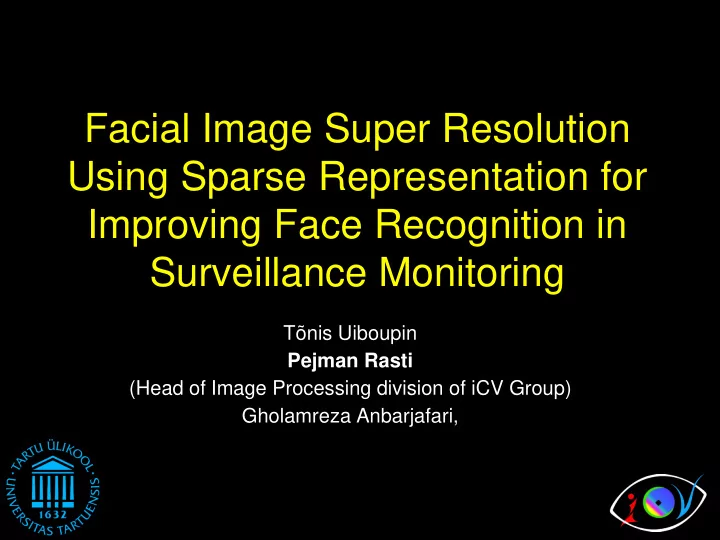

Facial Image Super Resolution Using Sparse Representation for Improving Face Recognition in Surveillance Monitoring Tõnis Uiboupin Pejman Rasti (Head of Image Processing division of iCV Group) Gholamreza Anbarjafari,
Outline • Problem • Introduction to super resolution • Introduction to face recognition • Proposed method • Experimental results • Conclusion
Face Recognition • Face recognition is of great importance in many computer vision applications, such as human-computer interactions, Security systems, Military and Homeland Security.
Problem • face recognition systems mostly work with images\videos of proper quality and resolution. • In videos recorded by surveillance camera, due to the distance between people and cameras, people are pictured very small and hence challenge face recognition algorithms
Problem Essex database Feret database HP database iFR database 99.20% 75.87% 31.6% 20% 50.67% 26.67% 98.06% 76.13%
Image up-sampling/enhancement • Image Interpolation • Super Resolution
image Interpolation • Image interpolation is one of the basic methods for up-sampling images • Some of the famous interpolation techniques are: – Nearest neighbor – Bilinear – Bicubic • The high frequency details are not restored
Image Super Resolution • The desire for high-resolution comes from two principal application areas: • Improvement of pictorial information for human interpretation • Helping representation for automatic machine perception • The application of SR techniques covers a wide range of purposes such as Surveillance video, Remote sensing, Medical imaging (CT, MRI, Ultrasound.).
Image Super Resolution domain Methods Frequency Fourier Wavelet Multiple Images Spatial Single image
Image Super Resolution Type How Multi-Images Set of low res. images Single-Image Image model/prior
Multiple-image super-resolution algorithms • Receive a couple of low-resolution images of the same scene as input and usually employee a registration algorithm to find the transformation between them.
Multiple-image super-resolution algorithms • Iterative back projection • Iterative adaptive filtering • Direct methods • Projection onto convex sets • Maximum likelihood • Maximum a posteriori
single-image super-resolution algorithms • During the sub-sampling or decimation of an image, the desired high-frequency information gets lost. Multiple super resolution methods cannot help recover the lost frequencies, especially for high improvement factors • Single-image super-resolution algorithms do not have the possibility of utilizing sub-pixel displacements, because they only have a single input.
single-image super-resolution algorithms • Learning-based single-image SR algorithms • Reconstruction-based single-image SR algorithms
single-image super-resolution algorithms • Learning-based single-image SR algorithms – These algorithms, as learning-based or Hallucination algorithms were first introduced in which a neural network was used to improve the resolution of fingerprint images. – These algorithms contain a training step in which the relationship between some HR examples (from a specific class like face images, fingerprints, etc.) and their LR counterparts is learned.
single-image super-resolution algorithms • Reconstruction-based single-image SR algorithms – These algorithms similar to their peer multiple image based SR algorithms try to address the aliasing artifacts that are present in the LR input image.
Face recognition • In general, face recognition consist of 5 steps – pre-processing – face detection – The facial components of region of interest (ROI) – feature extraction – classification
Face recognition • pre-processing – image enhancement – noise removal – both of them
Face recognition • face detection – Viola-Jones
Face recognition • The facial components of region of interest (ROI) – mouth – eyes – ear – cheeks – nose – fore-head – eyebrow
Face recognition • feature extraction – Local Binary Patterns (LBP) – Gabor filters – Linear Discriminant Analysis (LDA) – Principal Component Analysis (PCA) – Local Gradient Code (LGC) – Independent Component Analysis (ICA)
Face recognition • classification – support vector machine (SVM) – artificial neural network (ANN) classifier – Hidden Markov Model
solution • we investigate the importance of the state of-the-art super-resolution algorithm in improving recognition accuracies of the state-of-the-art face recognition algorithm for working with low-resolution images.
Proposed Method • Having a low-resolution input images, the proposed system upsamples it by the sparse representation super-resolution algorithm. Then, the SVD and Hidden Markov Model algorithm are used to perform face recognition on the high- resolution image.
Proposed Method
Databases
Experimental Result • The Essex, HP, ferret and ifr database has been employed.
Conclusion • State-of-the-art face recognition algorithms, like Hidden Markov Model and SVD have difficulties handling videos\images that are of low quality and resolution. • we have proposed to use upsampling techniques. • Experimental results on a down-sampled version of the benchmark databases show that the proposed is efficient in improving the quality of such lowresolution images and hence improves the recognition accuracy of the face recognition algorithm
Recommend
More recommend